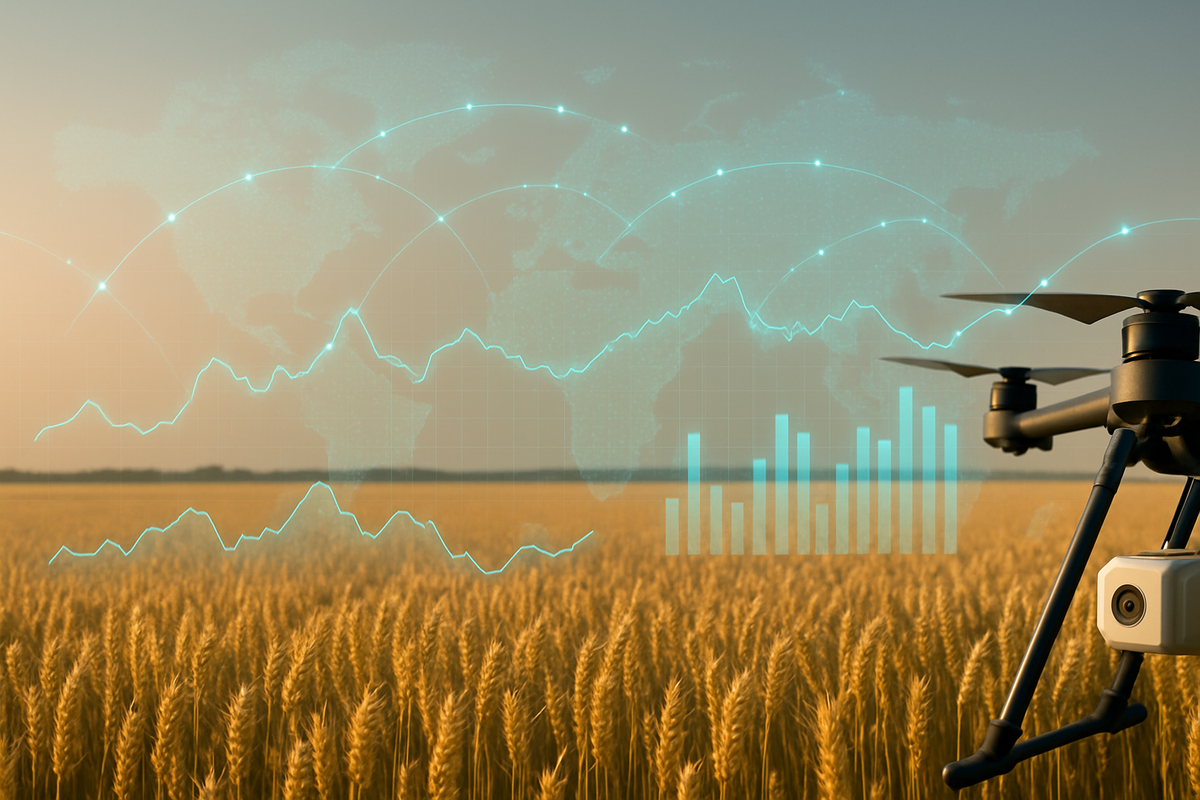
As of October 21, 2025, the global agricultural markets stand at a critical juncture, with participants keenly awaiting insights from the latest commodity reports. While specific figures for this future date are not yet available, a comprehensive report released around this time would undoubtedly scrutinize the culmination of the Northern Hemisphere's harvest, assess planting intentions for the Southern Hemisphere, and weigh in on the myriad of macroeconomic and geopolitical factors shaping food and feed supply chains. The immediate implications would center on price discovery for staple grains and oilseeds, influencing everything from consumer food costs to the profitability of major agribusinesses.
This hypothetical report would provide a crucial snapshot of supply and demand dynamics, potentially highlighting shifts in global inventories, changes in consumption patterns, and the ongoing impact of climate variability. Market participants would be looking for definitive trends in key commodities such as corn, wheat, soybeans, and palm oil, as well as updates on livestock and soft commodities. The insights gleaned would set the tone for market sentiment through the end of the year and into early 2026, guiding investment decisions and strategic planning across the agricultural sector.
Dissecting the Hypothetical October 2025 Agricultural Landscape
A detailed agricultural commodity report for October 21, 2025, would delve into a multitude of factors that have converged to shape the current market. Specific details would likely include the final yield assessments for major crops in the United States, Europe, and Russia, revealing whether earlier projections of bumper harvests or disappointing outputs have materialized. For instance, a persistent La Niña or El Niño weather pattern in the preceding months would have significantly impacted rainfall and temperatures in key growing regions, directly affecting crop conditions and harvest outcomes. The timeline of events leading up to this moment would encompass the entire growing season, from spring planting conditions and summer weather anomalies to autumn harvest progress. Any unexpected frosts, prolonged droughts, or excessive rainfall events would be meticulously documented, alongside their estimated impact on regional and global supply.
Key players and stakeholders involved in reacting to such a report would include major agricultural trading houses like Cargill and Archer-Daniels-Midland (NYSE: ADM), large-scale farming operations, food processing giants such as Nestlé (SWX: NESN) and Tyson Foods (NASDAQ: TSN), and national governments responsible for food security and trade policies. Initial market reactions would likely manifest as immediate price adjustments on futures exchanges, with a significant surplus in a major commodity potentially triggering a sell-off, while news of tighter supplies could spark a rally. For example, if the report indicated a substantial drawdown in global wheat stocks due to strong export demand from a geopolitical hotspot, wheat futures could see a sharp upward movement. Conversely, an unexpected surge in South American soybean planting intentions could put downward pressure on oilseed prices.
Corporate Fortunes: Winners and Losers in the Agricultural Arena
The findings of an October 2025 agricultural commodity report would inevitably create distinct winners and losers among public companies operating within the sector. Agribusiness giants like Bunge Global SA (NYSE: BG) and Wilmar International (SGX: F34), heavily involved in commodity origination, processing, and merchandising, would see their profitability directly tied to the supply-demand balance and price volatility. Companies with robust supply chain networks and diversified sourcing capabilities would be better positioned to capitalize on market dislocations or mitigate risks from regional crop failures. For instance, if grain prices are high, companies with extensive storage and transportation assets can benefit from arbitrage opportunities, while those reliant on purchasing raw materials might face squeezed margins.
Food processors and consumer goods companies, including Conagra Brands (NYSE: CAG) and General Mills (NYSE: GIS), are typically net buyers of agricultural commodities. A report indicating rising input costs for grains, sugar, or dairy could put significant pressure on their profitability, potentially leading to higher retail prices for consumers or a reduction in profit margins if they are unable to pass on increased costs. Conversely, a period of lower commodity prices could boost their margins and allow for more competitive pricing. Fertilizer producers such as Nutrien (TSX: NTR) and Mosaic (NYSE: MOS) would also be keenly watching the report; strong crop outlooks and favorable farmer economics generally translate into robust demand for crop inputs, while poor harvest expectations could dampen future sales. Companies involved in agricultural technology, like Deere & Company (NYSE: DE), would also be affected indirectly, as farm income directly influences equipment sales and technology adoption.
Wider Significance: Beyond the Harvest
The implications of the October 2025 agricultural commodity report would extend far beyond immediate price movements, fitting into broader industry trends and potentially triggering ripple effects across the global economy. One significant trend is the increasing impact of climate change on agricultural productivity and reliability. The report would likely underscore the growing volatility in weather patterns, making crop forecasting more challenging and accentuating the need for resilient agricultural practices and technologies. This could accelerate investment in drought-resistant crops, precision agriculture, and sustainable farming methods.
Potential ripple effects on competitors and partners would be substantial. For instance, if one major producing region experiences a severe crop shortfall, it could create export opportunities for other regions, shifting global trade flows and benefiting shipping and logistics companies. Regulatory and policy implications could also emerge, particularly if food security concerns are heightened. Governments might consider adjusting import/export tariffs, implementing strategic grain reserves, or providing subsidies to farmers to stabilize domestic supplies and prices. Historically, periods of high food inflation have often led to social unrest and political instability, making these reports crucial for policymakers. Comparisons to similar events, such as the 2012 U.S. drought or the 2007-2008 food price crisis, would be drawn to gauge the potential severity and duration of any market disruptions.
Charting the Course Ahead: What Comes Next
Looking ahead, the October 2025 agricultural commodity report would set the stage for several short-term and long-term possibilities. In the short term, market participants would closely monitor weather patterns in the Southern Hemisphere, where planting for key crops like soybeans and corn would be underway. Any deviations from normal conditions could quickly alter supply expectations and drive further price volatility. Traders would also be analyzing global demand indicators, particularly from major importers like China, to gauge the strength of consumption. Strategic pivots or adaptations required would include farmers adjusting their planting decisions for the next season based on current commodity prices and input costs, and food manufacturers potentially reformulating products or securing forward contracts to lock in prices.
Long-term possibilities would include accelerated investment in agricultural infrastructure, research and development for new crop varieties, and the expansion of irrigated land to mitigate climate risks. Market opportunities might emerge for companies specializing in sustainable agriculture, alternative proteins, or data analytics that can provide more accurate crop forecasting. Challenges could include persistent supply chain bottlenecks, rising geopolitical tensions impacting trade, and the ongoing pressure to meet increasing global food demand with finite resources. Potential scenarios range from a relatively stable market if supply and demand remain balanced, to periods of significant price inflation or deflation driven by unexpected weather events or geopolitical shifts.
A Comprehensive Wrap-Up: Navigating the Agricultural Market
In summary, a hypothetical agricultural commodity report for October 21, 2025, would serve as a vital compass for navigating the complex and often volatile world of agricultural markets. The key takeaways would revolve around the interplay of harvest outcomes, global demand, macroeconomic conditions, and the ever-present influence of climate. Investors would need to assess the balance between supply and demand for major commodities, paying close attention to inventory levels and export figures. The market moving forward would likely be characterized by continued sensitivity to weather forecasts and geopolitical developments, requiring agile responses from all stakeholders.
The lasting impact of such a report would be its contribution to the ongoing narrative of global food security and the sustainability of agricultural systems. It would underscore the necessity for innovation, international cooperation, and robust risk management strategies within the sector. What investors should watch for in the coming months includes the development of Southern Hemisphere crops, any shifts in government agricultural policies, and the broader economic indicators that influence consumer demand and trade flows. The agricultural market remains a dynamic arena, and informed analysis is crucial for navigating its inherent uncertainties.
This content is intended for informational purposes only and is not financial advice




